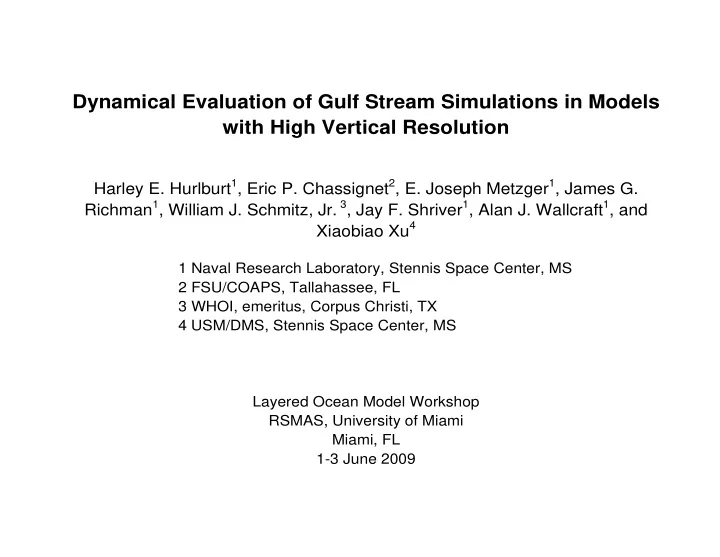

Dynamical Evaluation of Gulf Stream Simulations in Models with High Vertical Resolution Harley E. Hurlburt 1 , Eric P. Chassignet 2 , E. Joseph Metzger 1 , James G. Richman 1 , William J. Schmitz, Jr. 3 , Jay F. Shriver 1 , Alan J. Wallcraft 1 , and Xiaobiao Xu 4 1 Naval Research Laboratory, Stennis Space Center, MS 2 FSU/COAPS, Tallahassee, FL 3 WHOI, emeritus, Corpus Christi, TX 4 USM/DMS, Stennis Space Center, MS Layered Ocean Model Workshop RSMAS, University of Miami Miami, FL 1-3 June 2009
Focus of the evaluation Mean Gulf Stream pathway Inertial character of the surface currents Sea surface height variability Mean abyssal currents
Summer average pycnocline depth contours over 1980- 1983 from a 1/12 MICOM Atlantic simulation (CI=50 m) From Haza et al. (2007, Ocean Modelling)
Velocity vectors of the 1980-1983 deep mean flow from a 1/12 MICOM simulation superimposed on lower layer isopachs, or contours of potential thickness (h 2 f 0 /(f 0 + y )) From Haza et al. (2007, Ocean Modelling)
Observed Gulf Stream pathway using the 12 C isotherm at 400 m (Watts et al., 1995; JGR-O) ( ) vs simulations 14a (top) and 14c (bottom) over 1998-2000 from Bryan et al. (2007, Ocean Modelling) ( ). Simulations by 1/10 Atlantic POP model
RMS SSH variability over 1998-2000 for (a) simulation 14a, (b) simulation 14c, and (c) AVISO processed T/P and ERS altimeter data (Bryan et al., 2007, Ocean Model.). From Atlantic simulations using the Los Alamos POP model, a z-level model on a B-grid.
Gulf Stream region mean abyssal transport in the 3 -4 C class from a 1/10 Atlantic POP simulation From Hecht et al. (2008, AGU Monograph 177) using Smith and Gent (2004, JPO) simulation A´ Arrows are plotted for values of transport per unit width above an unspecified threshold
RAFOS float trajectories at ~1000 m (a-d) and ~1500 m (e-f) depth overlaid on topography contoured at 1 km intervals Circles on trajectories at 1 mo. intervals Star where float is entrained into the Gulf Stream ( ) Contemporaneous Gulf Stream IR northwall pathway ( ) Mean pathway From Bower and Hunt (2000b, JPO)
RAFOS float trajectories at 3500 m that do not retroflect into the interior overlaid on topography contoured at 1 km intervals Circles on trajectories at 1 mo. intervals Star where float crosses under the Gulf Stream ( ) Contemporaneous Gulf Stream IR northwall pathway ( ) Mean pathway From Bower and Hunt (2000b, JPO)
RAFOS float trajectories at 3500 m that retroflect into the interior overlaid on topography contoured at 1 km intervals Circles on trajectories at 1 mo. intervals Star where float crosses under the Gulf Stream ( ) Contemporaneous Gulf Stream IR northwall pathway ( ) Mean pathway From Bower and Hunt (2000b, JPO)
Mean SSH over years 12-15 from 1/12 global HYCOM simulation 9.4 with the mean Gulf Stream IR northwall pathway by Cornillon and Sirkes overlaid contour interval = 5 cm
Observed 1/12 global HYCOM years 12-15, Exp. 9.4 SSH variability observed by altimetry vs 1/12 and 1/25 global HYCOM Variability from altimetry is calculated along altimeter tracks from satellites in 4 different orbits 1/25 global HYCOM year 3, Exp. 1.0
1/12 global HYCOM mean 0.9 currents from Exp. 9.4 yrs 12-15 0.75 0.6 (top) near surface (layer 6) and (bottom) abyssal (layer 27) with 0.45 topographic contours and the 0.3 mean Gulf Stream IR northwall 0.15 pathway by Cornillon and Sirkes overlaid. Mean max. current speed (m/s) Near 75 W Mean 75 ‐ 70 W 0.12 1/12 HYCOM 1.34 0.89 0.1 1/16 NLOM 1.70 1.39 0.08 Ratio N/H 1.27 1.56 0.06 N/H = NLOM/HYCOM 0.04 0.02
Mass Transport Streamfunction from a Barotropic Linear Simulation Forced by a QuiKSCAT-Corrected ECMWF ERA40 Wind Stress Climatology Sverdrup (1947) interior flow with Munk (1950) western boundary layers Observed mean IR north wall pathway (1982 ‐ 1996) +/ ‐ 1 std. dev. by Cornillon and Sirkes CI = 2 Sv
Atlantic Meridional Overturning Streamfunction from 1/12 Global HYCOM Transport Steamfunction (Sv) Exp 9.4 Years 12-15
1/12 vs 1/25 global HYCOM mean current speed and vectors overlaid on topography in upper ocean (layer 6, 20-25 m) and abyssal ocean (layer 27, 3100-3650 m) m/s m/s 1/12 1/25 0.9 L6 L6 0.75 0.6 0.45 0.3 0.15 m/s m/s m/s 1/12 1/25 0.12 L27 L27 0.1 0.08 0.06 0.04 0.02 m/s 1/12 Exp 9.4, years 12-15 1/25 Exp 1.0, year 3
Dynamical Evaluation in the Gulf Steam Region: Summary and Conclusions Given an understanding of Gulf Stream dynamics - supported by a wide range of observational evidence in the upper and abyssal ocean We can evaluate Gulf Stream simulations dynamically - Allows us to identify relationships between flaws in the simulation and flaws in the dynamics - Helps us identify specific improvements that are needed - Much more powerful approach than the traditional focus on improving parameterizations of subgrid-scale processes and on parameter tuning
Recommend
More recommend